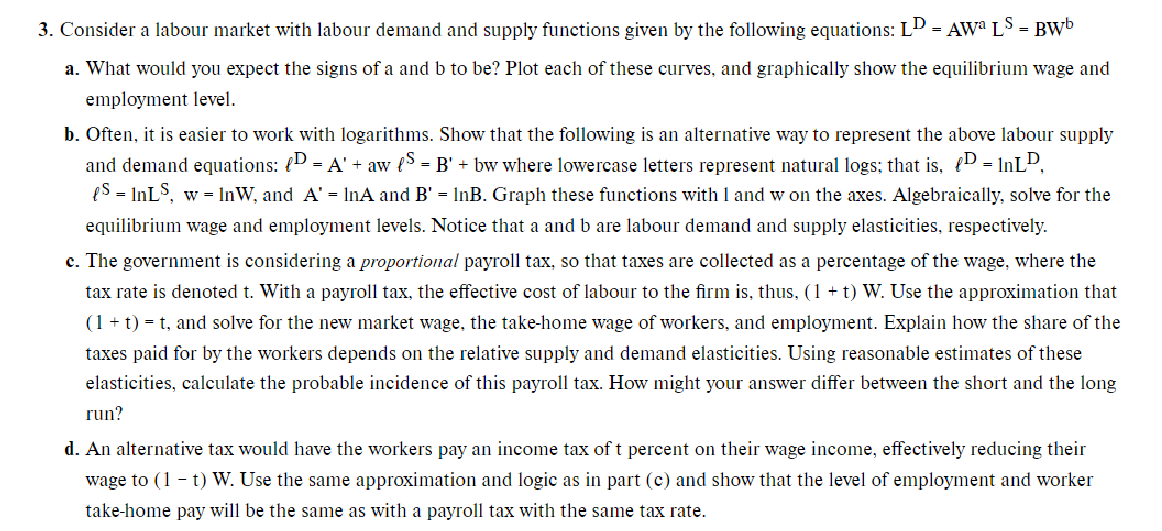
3. Consider a labour market with labour demand and supply functions given by the following equations: LD = AW LS = BWb a. What would you expect the signs of a and b to be? Plot each of these curves, and graphically show the equilibrium wage and employment level. b. Often, it is easier to work with logarithms. Show that the following is an alternative way to represent the above labour supply and demand equations: D = A' + aw (S = B' + bw where lowercase letters represent natural logs; that is, D = InLD, S = InLS, w = InW, and A' = InA and B' = InB. Graph these functions with 1 and won the axes. Algebraically, solve for the equilibrium wage and employment levels. Notice that a and b are labour demand and supply elasticities, respectively. c. The government is considering a proportional payroll tax, so that taxes are collected as a percentage of the wage, where the tax rate is denoted t. With a payroll tax, the effective cost of labour to the firm is, thus, (1+t) W. Use the approximation that (1 + t) = t, and solve for the new market wage, the take-home wage of workers, and employment. Explain how the share of the taxes paid for by the workers depends on the relative supply and demand elasticities. Using reasonable estimates of these elasticities, calculate the probable incidence of this payroll tax. How might your answer differ between the short and the long run? d. An alternative tax would have the workers pay an income tax of t percent on their wage income, effectively reducing their wage to (1 t) W. Use the same approximation and logic as in part (c) and show that the level of employment and worker take-home pay will be the same as with a payroll tax with the same tax rate. 3. Consider a labour market with labour demand and supply functions given by the following equations: LD = AW LS = BWb a. What would you expect the signs of a and b to be? Plot each of these curves, and graphically show the equilibrium wage and employment level. b. Often, it is easier to work with logarithms. Show that the following is an alternative way to represent the above labour supply and demand equations: D = A' + aw (S = B' + bw where lowercase letters represent natural logs; that is, D = InLD, S = InLS, w = InW, and A' = InA and B' = InB. Graph these functions with 1 and won the axes. Algebraically, solve for the equilibrium wage and employment levels. Notice that a and b are labour demand and supply elasticities, respectively. c. The government is considering a proportional payroll tax, so that taxes are collected as a percentage of the wage, where the tax rate is denoted t. With a payroll tax, the effective cost of labour to the firm is, thus, (1+t) W. Use the approximation that (1 + t) = t, and solve for the new market wage, the take-home wage of workers, and employment. Explain how the share of the taxes paid for by the workers depends on the relative supply and demand elasticities. Using reasonable estimates of these elasticities, calculate the probable incidence of this payroll tax. How might your answer differ between the short and the long run? d. An alternative tax would have the workers pay an income tax of t percent on their wage income, effectively reducing their wage to (1 t) W. Use the same approximation and logic as in part (c) and show that the level of employment and worker take-home pay will be the same as with a payroll tax with the same tax rate







